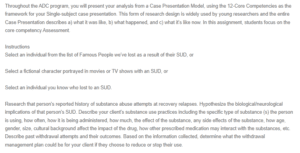Physiology of Substance Abuse – Kurt Cobain
History of Substance Abuse
For this assignment, I selected to focus on the famous artist Kurt Cobain, who struggled with substance abuse throughout his life. Cobain’s substance abuse history includes significant usage of heroin and prescription medicines to treat chronic pain and depression. He attempted countless times to rehabilitate, including multiple sessions in rehab and detoxification programs. Unfortunately, he had several relapses, which ultimately led to his untimely suicide in 1994. This case exemplifies the complicated and difficult nature of substance use disorders, as well as the obstacles that individuals confront in obtaining and maintaining recovery.
Biological/Neurological Implications
Kurt Cobain’s substance use disorder (SUD) most certainly has serious medical and neurological consequences. Long-term heroin use can alter the brain’s reward system, changing neurotransmitters such as dopamine (Anghel et al., 2023). This change can lead to increased desires and a reduced ability to enjoy pleasure from natural rewards. Chronic drug use can also cause structural changes in the brain, which can have an impact on decision-making, impulse control, and emotional regulation. Furthermore, the combination of prescription medicines and heroin may have amplified these effects, contributing to the severity of Cobain’s SUD and making recovery more difficult.
Substance Use Practices
Kurt Cobain’s drug use was mostly focused on heroin, a highly addictive narcotic. He was known to use heroin on a regular basis, typically injecting it to get the drug’s powerful and quick effects. Cobain’s heroin usage was persistent and frequent, leading to serious physical and psychological dependence. This constant and strong usage of heroin was crucial to his lifelong fight with substance abuse.
Effects of the Substance
Kurt Cobain administered heroin primarily through intravenous injection, a method that delivers the drug rapidly into the bloodstream, intensifying its effects. The specific dosage and frequency of his heroin use varied but often involved high amounts, which contributed to the rapid development of tolerance and addiction. Heroin’s effects include euphoria, pain relief, and a sense of relaxation, but they are accompanied by side effects such as drowsiness, impaired cognition, respiratory depression, and constipation. Age, gender, size, and cultural background can impact an individual’s response to heroin, with factors like body weight and genetics influencing tolerance and sensitivity (Sapir-Pichhadze & Oertelt-Prigione, 2023). Additionally, interactions between heroin and other prescribed medications, such as Cobain’s use of prescription opioids for chronic pain, can increase the risk of overdose and complicate the treatment of both substance use disorder and underlying health conditions.
Past Withdrawal Attempts and Their Outcomes
Kurt Cobain attempted multiple withdrawals from heroin and other narcotics in the past, but most of these attempts were unsuccessful. He frequently had significant withdrawal symptoms, including acute cravings, restlessness, anxiety, muscle pain, and nausea, making it extremely difficult to refrain from drug use. Cobain’s attempts to quit usually resulted in relapses since the misery of withdrawal led him back to substance use to relieve these symptoms. He struggled to sustain long-term abstinence despite several stints in rehabilitation institutions. Much of his battle with substance use disorder was marked by a cycle of detoxification followed by relapse. These previous withdrawal attempts highlight the enormous difficulties of treating heroin addiction and the significance of comprehensive and continuous treatment solutions for those confronting such a daunting struggle.
Withdrawal Management Plan
Kurt Cobain’s withdrawal management strategy, which would aim to limit or stop his heroin usage, could have prioritized his safety while also addressing the physical and psychological components of addiction. Given his history of significant heroin usage, it could be imperative to begin with a medically supervised detoxification process in an inpatient facility to handle potentially severe withdrawal symptoms such as nausea, vomiting, anxiety, and cravings. Methadone or buprenorphine may be considered to alleviate withdrawal symptoms and lower the risk of relapse. Concurrently, a thorough treatment plan, including psychotherapy, counselling, and support groups, could be designed to address the underlying causes of his addiction, give coping techniques, and encourage long-term recovery.
References
Anghel, D. C., Nitescu, G. V., Tiron, A. T., Guțu, C. M., & Baconi, D. L. (2023). Understanding the mechanisms of action and effects of drugs of abuse. Molecules, 28(13), 4969. https://doi.org/10.3390/molecules28134969
Sapir-Pichhadze, R., & Oertelt-Prigione, S. (2023). P32: a sex- and gender-sensitive model for evidence-based precision medicine: from knowledge generation to implementation in the field of kidney transplantation. Kidney International, 103(4), 674–685. https://doi.org/10.1016/j.kint.2022.12.026
ORDER A PLAGIARISM-FREE PAPER HERE
We’ll write everything from scratch
Question

Physiology of Substance Abuse – Kurt Cobain
Throughout the ADC program, you will present your analysis from a Case Presentation Model, using the 12-Core Competencies as the framework for your Single-subject case presentation. This form of research design is widely used by young researchers and the entire Case Presentation describes a) what it was like, b) what happened, and c) what it’s like now. In this assignment, students focus on the core competency Assessment.
Instructions
Select an individual from the list of Famous People we’ve lost as a result of their SUD, or
Select a fictional character portrayed in movies or TV shows with an SUD, or
Select an individual you know who lost to an SUD.
Research that person’s reported history of substance abuse attempts at recovery relapses. Hypothesize the biological/neurological implications of that person’s SUD. Describe your client’s substance use practices including the specific type of substance (s) the person is using, how often, how it is being administered, how much, the effect of the substance, any side effects of the substance, how age, gender, size, cultural background affect the impact of the drug, how other prescribed medication may interact with the substances, etc. Describe past withdrawal attempts and their outcomes. Based on the information collected, determine what the withdrawal management plan could be for your client if they choose to reduce or stop their use.
Length: Your post should be roughly 6-8 paragraphs in length
References: Cite (at least 1) sources you reference in-text and under a “References” section in APA format.
https://nationalu.brightspace.com//content/enforced/63935-ADC215-55630-2310/Interactives/CLO_interactive/story.html?ou=63935


